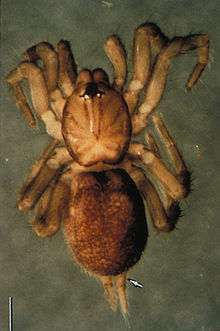Spruce-fir moss spider
| Spruce-fir moss spider | |
|---|---|
 | |
| Scientific classification | |
| Kingdom: | Animalia |
| Phylum: | Arthropoda |
| Subphylum: | Chelicerata |
| Class: | Arachnida |
| Order: | Araneae |
| Infraorder: | Mygalomorphae |
| Family: | Dipluridae |
| Genus: | Microhexura |
| Species: | M. montivaga |
| Binomial name | |
| Microhexura montivaga | |
| Synonyms[1] | |
| |
The spruce-fir moss spider, Microhexura montivaga, is an endangered species of spider found at high elevations in the southern Appalachian Mountains. First identified in 1923, it inhabits moss that grows on rocks underneath the forest canopy.
Description
M. montivaga is one of the smallest mygalomorph spiders, with adults only measuring 3 to 4 mm (about 1/8 inch). The coloration varies from light brown to yellow-brown to a darker reddish brown, with no markings on the abdomen. The chelicerae project forward, and one pair of spinnerets is very long. It possesses a second pair of book lungs, which appear as light patches behind the genital furrow.[2]
Biology
M. montivaga constructs tube-shaped webs, apparently for shelter, for prey has never been found in them. It probably feeds on springtails that are abundant in moss mats.[2] M. montivaga can take as long as three years to reach maturity, due to low temperatures and resulting slow metabolism.
Endangered status
The widespread death of Fraser fir trees has destroyed many habitats for M. montivaga, and the spider species was listed as endangered in 1995. Many Fraser firs have died due to infestation with Adelges piceae, the balsam woolly adelgid, an insect pest introduced from Europe. The resulting thinning of the forest canopy leads to the drying of the moss mats that are essential for the spider's survival, as it requires climates of high and constant humidity.[2]
Distribution
M. multivaga is known from Fraser fir and red spruce forests on mountain peaks at and above 1,650 m (5,410 ft) in the Southern Appalachian Mountains of North Carolina and Tennessee. It has been recorded from Clingmans Dome and Mount Collins (both very small populations), Mount Le Conte, Mount Mitchell (probably extirpated), Grandfather Mountain, and Roan Mountain.
The Tennessee population, located in Sevier County, was considered healthy up to 1989, but is now possibly extirpated. On two locations in North Carolina, there was only one spider found each in recent years. Only the population along the Avery/Caldwell County line in North Carolina seems to be relatively stable. This population appears to be restricted to the moss mats on a single rock outcrop and a few surrounding boulders.[2]
References
- 1 2 "Taxon details Microhexura montivaga Crosby & Bishop, 1925", World Spider Catalog, Natural History Museum Bern, retrieved 2016-03-15
- 1 2 3 4 "Spruce-fir Moss Spider in North Carolina", North Carolina Ecological Services, U.S. Fish and Wildlife Service, retrieved 2016-03-15
External links
- "Spruce-fir moss spider", Asheville Ecological Services Field Office, U.S. Fish and Wildlife Service, retrieved 2016-03-15
